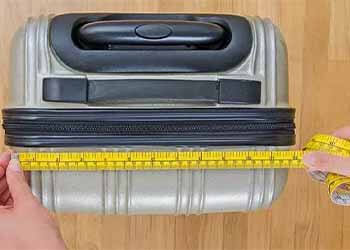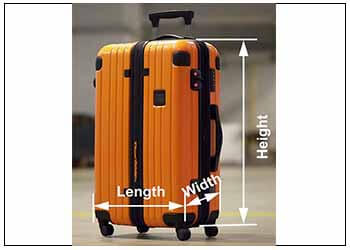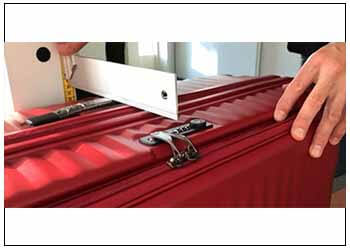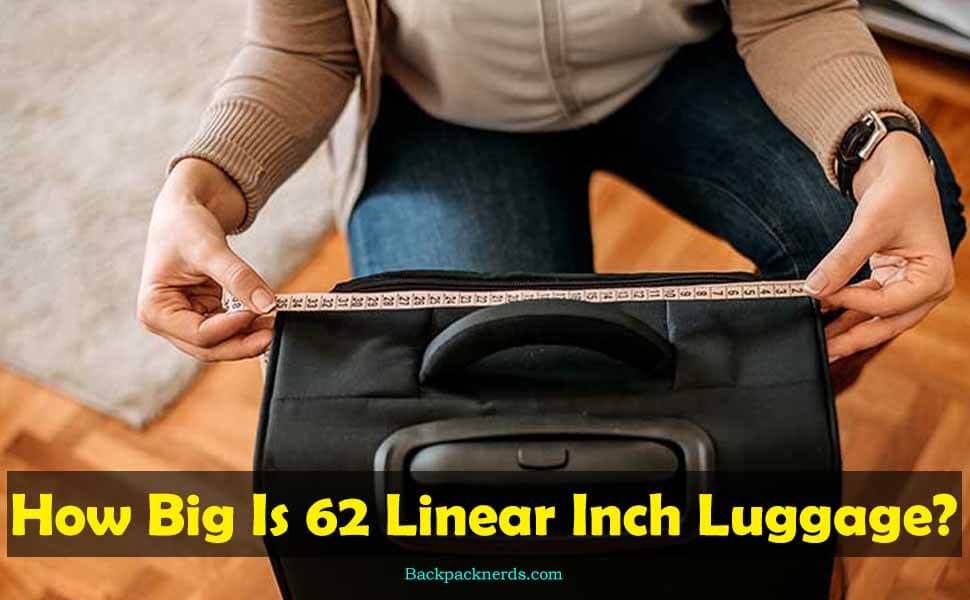Are you planning your next adventure and wondering how big is 62 linear inch luggage? Well, you are thinking right. When it comes to travel, having the right luggage is essential, and 62 linear inch luggage is a popular choice for many globetrotters. But what exactly does it mean? Simply put, 62 linear inches is the sum of a suitcase’s length, width, and height, and it’s a measurement used by airlines to determine whether your luggage qualifies as standard checked baggage. In this guide, we’ll explore the versatility and convenience of 62 linear inch luggage, helping you make an informed decision for your next journey. So, let’s dive in and discover the world of spacious and practical travel companions!
Before we dive in, we need to know what is a 62 inch linear luggage.
What exactly is 62 inch linear luggage?

What does 62 linear inches mean for luggage? Or what do you understand by 62 inches luggage dimensions?
Or simply, what is a 62 inch luggage?
Well, a 62 linear inch luggage refers to a suitcase’s total measurement when you add together its length, width, and height. It’s a common standard used by airlines to determine whether a piece of luggage qualifies as standard checked baggage or if it falls into the oversized category. This measurement is crucial because it can affect baggage fees, as airlines often charge more for oversized luggage. So, when you see luggage labeled as 62 linear inches, it means the sum of its three dimensions should not exceed this limit, making it suitable for most checked baggage allowances on flights. However, it’s a convenient size for travelers looking for a balance between packing space and airline regulations.
To understand what 62 linear inch luggage is, let’s break it down:
Imagine you have a suitcase that is 24 inches long, 18 inches wide, and 20 inches tall. To find its total linear inches, simply add these three dimensions together:
24 inches (length) + 18 inches (width) + 20 inches (height) = 62 linear inches.
So, in this example, your suitcase would be considered 62 linear inch luggage because the sum of its length, width, and height equals 62 inches. Airlines often use this measurement to define size restrictions for checked baggage. It’s a handy way to ensure your luggage complies with airline regulations and avoids additional fees for oversized items.
How to Measure Linear Inches?

It is a big question – how to calculate linear dimensions for your suitcase? Besides this one, you may have to face some same questions like –
How do you measure luggage linear inches? Can I measure a checked luggage into linear inches? How do I measure a 62 inches linear luggage?
Well, let’s know about them.
Measuring linear inches is a straightforward process that involves adding together the length, width, and height of an object. This measurement is commonly used for luggage to determine if it meets airline size restrictions.
Here’s a step-by-step guide on how to measure linear inches:
Step 1: Gather Your Equipment
To measure linear inches, you’ll need a ruler or a tape measure. Make sure it’s long enough to measure the largest dimension of the object.
Step 2: Place the Object on a Flat Surface
Set the object you want to measure on a flat and even surface. Ensure it’s fully extended and not compressed in any way.
Step 3: Measure the Length
Using your ruler or tape measure, measure the longest dimension of the object. This is typically the length, which is the longest side from one end to the other.
Step 4: Measure the Width
Next, measure the width of the object, which is the distance from one side to the opposite side, perpendicular to the length.
Step 5: Measure the Height
Measure the height of the object, which is the distance from the bottom to the top, perpendicular to both the length and width.
Step 6: Add the Measurements Together
Finally, add the measurements of the length, width, and height together. This sum is the linear inches of the object.
Examples of Measuring Linear Inches
The formula to measure luggage into Linear Inches is-
Linear Inches = Length + Width + Height
For example, if you have a suitcase with dimensions of 24 inches in length, 16 inches in width, and 10 inches in height:
Linear inches = 24 inches (length) + 16 inches (width) + 10 inches (height) = 50 linear inches.
So, in this case, the suitcase measures 50 linear inches. Airlines often have specific limits for linear inches to determine whether luggage qualifies as standard or oversized, so it’s essential to measure correctly to ensure compliance with their regulations.
In this way, you can measure a 62 inch linear luggage. For example: (28 + 20 + 14) = 62
So, if the total sum of a suitcase (L+B+H) is equal to 62 inches, it means you are carrying a luggage 62 linear inches.
How to Convert Linear Inches to Centimeters?
Sometimes you may think, how do I convert a luggage in linear inches to centimeters? Well, if you really don’t know, you can know from here.
To convert linear inches to centimeters, you can use the following conversion factor:
1 inch = 2.54 centimeters
Here’s how you can convert linear inches to centimeters:
Multiply the number of linear inches by 2.54: This will give you the equivalent measurement in centimeters.
So, if you ask what is 62 inch luggage dimensions in cm? And, how can I measure the inches to centimeters?
Well, let’s say you have a suitcase that measures 62 linear inches, and you want to convert it to centimeters:
In this case, multiply 62 by 2.54.
So, 62 linear inches * 2.54 centimeters/inch = 157.48 centimeters
Therefore, 62 linear inches is equal to 157.48 centimeters or (approximately 158 cm). This is how you can measure a 62 linear inches luggage in cm.
How to Convert Centimeters to Linear Inches?
If you have measured your luggage in cm and you want to convert it into Inches. So, how would you do that?
Well, to convert centimeters to linear inches, you can use the following conversion factor:
1 centimeter = 0.393701 linear inches
Here’s how you can convert centimeters to linear inches:
Multiply the number of centimeters by 0.393701: This will give you the equivalent measurement in linear inches.
For example, if you have an object that measures 100 centimeters, and you want to convert it to linear inches:
100 centimeters * 0.393701 linear inches/centimeter = 39.37 linear inches
So, 100 centimeters is equal to approximately 39.37 linear inches.
What are 62 Linear Inches in Centimeters?

To convert linear inches to centimeters, you can use the following conversion factor: 1 inch = 2.54 centimeters. So, to find the equivalent of 62 linear inches in centimeters, you would multiply 62 by 2.54.
Here is an example:
62 linear inches * 2.54 cm/inch = 157.48 cm. So, 62 linear inches is approximately equal to 157.48 centimeters.
Let’s say you have a suitcase that measures 62 linear inches in total (the sum of its length, width, and height). To find its size in centimeters, you would multiply 62 by 2.54: 62 linear inches * 2.54 cm/inch = 157.48 cm or 158 cm. Therefore, a suitcase that measures 62 linear inches is approximately 157.48 or 158 centimeters in size.
This conversion can help you understand the dimensions of an object in both inches and centimeters, which is useful for international travel and when dealing with different measurement systems.
How Big Is 62 Linear Inch Luggage?

What do you think- how big is 62 linear inches luggage or what is 62 linear inches for luggage? Is it really big or not?
A 62 linear inch luggage refers to the size of a suitcase or bag when you add together its length, width, and height. This measurement is commonly used by airlines to determine whether your luggage fits within their size restrictions for checked baggage.
To illustrate, let’s say you have a suitcase that is 24 inches long, 18 inches wide, and 20 inches tall. To find its total linear inches, simply add these three dimensions together:
24 inches (length) + 18 inches (width) + 20 inches (height) = 62 linear inches.
So, your suitcase is considered 62 linear inch luggage because the sum of its dimensions equals 62 inches. This size is quite versatile and typically falls within the standard checked baggage limits for most airlines.
It’s essential to note that different airlines may have slightly varying size restrictions, so it’s a good idea to check with your specific airline to ensure your luggage complies with their guidelines. But generally, 62 linear inch luggage provides a good balance between packing space and adhering to airline regulations, making it a popular choice for travelers. It’s a convenient size that allows you to pack efficiently for your journeys without worrying about extra fees for oversized baggage.
Should I Measure The Weight of My Luggage?
Yes, measuring the weight of your luggage is crucial when you’re preparing for a trip, especially if you’re flying. Here’s why:
Airlines Have Weight Limits:
Most airlines have specific weight limits for both carry-on and checked luggage. Exceeding these limits can result in additional fees or even having to repack or remove items at the airport. By measuring the weight of your luggage before heading to the airport, you can avoid unpleasant surprises.
Avoid Excess Baggage Fees:
Airlines often charge extra fees for luggage that exceeds their weight limits. These fees can be quite costly, so measuring your luggage’s weight helps you stay within the allowed limits and save money.
Safety and Convenience:
Carrying luggage that’s too heavy can be physically challenging, particularly if you have to transport it through airports, train stations, or hotels. Overweight luggage can also increase the risk of injury. Measuring the weight allows you to pack more sensibly and avoid unnecessary strain.
Compliance with Regulations:
Different modes of transportation, such as buses, trains, or cruise ships, may also have weight restrictions for luggage. Knowing your luggage’s weight ensures you comply with these regulations and helps make your journey smoother.
To measure your luggage’s weight accurately, you can use a luggage scale or a standard bathroom scale. Place your luggage on the scale and note the weight in pounds or kilograms, depending on your preferred unit of measurement.
In summary, measuring the weight of your luggage is a simple yet essential step to ensure a hassle-free and cost-effective travel experience. It helps you stay within airline and transportation regulations, avoid fees, and travel more comfortably.
Some Best Luggage for You: Recommended from Amazon
Do Wheels Count When Measuring Checked Baggage?

When measuring checked baggage, the general rule is that wheels are typically included in the measurements, along with the handle, zippers, and any other protruding parts of the luggage. This means that the dimensions of your luggage should account for the entire exterior of the bag, including any wheels and handles.
For example, if your suitcase measures 26 inches in length, including its wheels, and 18 inches in width, including any handles or pockets, and 12 inches in height, including any protruding parts, then the sum of these measurements would be used to calculate its linear inches for airline size restrictions. In this case, it would be:
26 inches (length) + 18 inches (width) + 12 inches (height) = 56 linear inches.
So, the suitcase would be considered as 56 linear inches in size.
It’s important to note that specific airline policies may vary slightly, so it’s a good idea to check with your airline to understand their exact guidelines for measuring checked baggage. However, as a general practice, including wheels and other protruding parts in your measurements is a safe way to ensure your luggage complies with size restrictions.
What Should Be The Maximum Size Of Checked Luggage?
The maximum size of checked luggage can vary depending on the airline and its specific policies. There isn’t a universal maximum size for checked luggage that applies to all airlines. Airlines set their own size restrictions for checked baggage, and these limits can differ from one carrier to another.
However, a common guideline for many airlines is a maximum size of around 62 linear inches (or approximately 158 centimeters) when you add together the length, width, and height of the bag. However, this is not a strict rule for all airlines, and some may allow slightly larger or smaller dimensions.
To determine the maximum size of checked luggage for your specific flight, you should:
- Check with Your Airline: Visit the airline’s official website or contact their customer service to find the most up-to-date information on baggage size restrictions. Airlines often provide detailed information about baggage allowances, including dimensions, on their websites.
- Review Your Ticket: The size limits for checked luggage may also be specified on your airline ticket or in your booking confirmation. Pay close attention to any baggage-related information provided by the airline during the booking process.
- Consider Your Ticket Class: Some airlines may have different size allowances for passengers traveling in different classes, such as economy, premium economy, business class, and first class. Make sure you are aware of the size limits associated with your ticket class.
- Be Aware of Fees: If your luggage exceeds the airline’s maximum size limits, it may be considered oversized, and you could incur additional fees. Understanding the size restrictions in advance can help you avoid unexpected charges.
It’s important to note that airline policies can change over time, so it’s essential to verify the specific baggage size limits for your flight with the airline you’ll be traveling with. Checking with the airline well before your departure date will ensure that you comply with their baggage size restrictions and have a smooth travel experience.
What If My Suitcase Is Larger Than 62 Inches?

If your suitcase is larger than the maximum size allowed by the airline, which is commonly around 62 linear inches (or approximately 158 centimeters), you may encounter several scenarios and options:
1. Additional Fees:
Airlines often charge extra fees for oversized baggage. These fees can vary widely depending on the airline and can be quite costly. Be prepared to pay these fees at the airport if your suitcase exceeds the size limit.
2. Repack or Reduce Size:
You may need to repack your suitcase or remove items to reduce its size if it exceeds the airline’s limit. This can be a time-consuming and inconvenient process, so it’s best to avoid this situation whenever possible.
3. Upgrade to a Higher Class:
Some airlines offer larger baggage allowances for passengers traveling in higher classes, such as business or first class. If you’re willing to pay for an upgrade, this might allow you to bring a larger suitcase without incurring additional fees.
4. Ship Your Luggage:
If you’re concerned about the size of your luggage and the associated fees, consider shipping your luggage to your destination separately using a shipping service. This can sometimes be more cost-effective than paying oversized baggage fees, especially for particularly large or heavy items.
5. Check Airline Policies:
Always check the specific baggage policies of the airline you’re flying with. Some airlines may have more lenient or stricter size limits, so it’s crucial to know their rules in advance to plan accordingly.
6. Consider Alternatives:
If you frequently travel with oversized items or find that your luggage often exceeds airline size limits, you might consider investing in luggage that meets the size requirements of most airlines. Look for suitcases that are designed to maximize packing space while staying within standard size limits.
In summary, if your suitcase is larger than 62 inches (or the specified maximum size limit of the airline you’re flying with), it’s essential to be aware of the potential fees and inconveniences you may encounter. Planning ahead, understanding airline policies, and packing within size limits can help you avoid these issues and ensure a smoother travel experience.
What Should I Check Again About My Luggage Before Traveling?
Before traveling, it’s essential to thoroughly check your luggage to ensure you have everything you need and that your baggage complies with airline and security regulations. Here’s a checklist of what to verify:
1. Travel Documents:
- Passport and visa (if required)
- Driver’s license or identification card
- Boarding passes
- Travel insurance documents
- Itinerary and hotel reservations
- Any necessary travel permits or visas
2. Luggage and Packing:
- Check that you’ve packed all essential clothing and items for your trip.
- Ensure you have enough underwear, socks, and any specialized clothing (e.g., swimsuits, formal attire).
- Pack any medications and prescriptions.
- Verify that you have travel-sized toiletries and personal care items.
- Double-check for important documents, such as tickets, itineraries, and hotel reservations.
- Make sure you have all necessary chargers and adapters for electronic devices.
- Don’t forget travel essentials like a neck pillow, eye mask, and earplugs for added comfort during the journey.
3. Luggage Dimensions and Weight:
- Measure your luggage to ensure it complies with the airline’s size restrictions, especially if you have a 62 linear inch bag.
- Weigh your luggage to confirm it doesn’t exceed the airline’s weight limit.
- Consider bringing a luggage scale to double-check the weight at the airport.
4. Locks and Security:
- Ensure that your luggage is securely locked with TSA-approved locks, if applicable.
- Remove any prohibited items from your luggage, such as sharp objects, liquids in containers exceeding 3.4 ounces (100 ml), or flammable materials.
5. Travel Essentials:
- Verify that you have essential travel items like your wallet, keys, and phone.
- Pack travel adapters if you’re traveling internationally.
- Include a copy of your travel insurance policy and emergency contact information in your carry-on.
6. Travel Comfort and Health:
- Prepare for in-flight comfort by having items like a neck pillow, earplugs, and eye mask in your carry-on.
- Bring any necessary medications, prescriptions, or medical supplies.
- Check for any required vaccinations or health precautions for your destination.
7. Valuables and Important Items:
- Keep valuable items such as laptops, cameras, and jewelry in your carry-on bag.
- Carry important documents like passports and travel insurance information with you in your carry-on as well.
8. Airport and Security Checkpoints:
- Verify your flight’s departure time and gate information before heading to the airport.
- Ensure you have your boarding pass and identification ready for security checks.
9. Baggage Tags:
- Attach clear and legible baggage tags with your name, contact information, and destination address to your checked luggage.
- Place identification tags on your carry-on as well.
10. Airport Parking and Transportation:
- Confirm your airport parking reservation (if applicable) and have the necessary documentation.
- Arrange transportation to the airport, whether it’s a shuttle service, taxi, or rideshare.
By going through this checklist before traveling, you can reduce the chances of forgetting important items, ensure your luggage is within regulations, and make your journey more comfortable and hassle-free.
How to Choose the Perfect 62 Linear Inches Luggage?

Choosing the perfect 62 linear inch luggage involves considering several factors to ensure it meets your specific travel needs. Here’s a step-by-step guide to help you make the right choice:
1. Check Airline Regulations:
Before anything else, familiarize yourself with the size limits and weight restrictions of the airlines you frequently travel with. Make sure the luggage you choose complies with these requirements, which are typically around 62 linear inches.
2. Consider Your Travel Needs:
- Duration of Trips: Think about the length of your trips. If you frequently take long trips, you may need larger luggage to accommodate more clothing and essentials.
- Travel Style: Consider your travel style. If you’re a minimalist packer, a smaller suitcase might suffice, while those who like to pack more may prefer larger luggage.
- Mode of Travel: If you primarily travel by car, size constraints may be less important than if you often fly, where airlines have specific luggage size limits.
3. Durability:
Look for luggage made from durable materials, such as polycarbonate or ballistic nylon, to withstand the rigors of travel. Check the quality of zippers, handles, and wheels to ensure they are sturdy.
4. Wheels:
Opt for luggage with multidirectional spinner wheels for ease of maneuverability. Spinner wheels allow you to move the suitcase in any direction, making it more convenient to navigate crowded airports and tight spaces.
5. Handles:
Choose luggage with retractable handles that lock in multiple positions. Telescopic handles are essential for comfortably pulling your suitcase.
6. Expandability:
Consider luggage with expansion features. Expandable suitcases have zippers that allow you to increase the interior space when needed. This flexibility can be handy for accommodating extra items you pick up during your travels.
7. Organization:
Look for luggage with interior pockets, dividers, and straps to help you organize your belongings efficiently. Some suitcases come with built-in garment bags or toiletry compartments.
8. Security Features:
Consider luggage with built-in TSA-approved locks or external lockable zippers to keep your belongings secure.
9. Weight:
Pay attention to the weight of the suitcase itself, as it can affect how much you can pack before reaching weight limits imposed by airlines.
10. Brand and Warranty:
Research reputable luggage brands known for quality and customer service. Many brands offer warranties that cover damage or defects.
11. Reviews and Recommendations:
Read reviews from other travelers and seek recommendations from friends or online forums to get real-world feedback on specific luggage models.
12. Budget:
Set a budget for your luggage purchase. While quality is essential, there are options available at various price points.
13. Test It Out:
If possible, visit a store to physically handle and test the luggage. Check how it rolls, how it feels when packed, and if it meets your storage and organization needs.
Remember that the “perfect” luggage can vary from person to person based on individual preferences and travel habits. It’s essential to choose luggage that suits your specific needs and aligns with the type of travel you typically engage in.
Frequently Asked Questions [62 linear inch luggage]
Q1: What is 62 linear inch luggage?
A1: 62 linear inch luggage refers to the total measurement of a suitcase, including its length, width, and height. It’s commonly used by airlines to determine whether a piece of luggage qualifies as standard checked baggage. You can check passenger baggage rules.
Q2: How do I measure my luggage in linear inches?
A2: To measure in linear inches, simply add the length, width, and height of your luggage together. For example, if your suitcase is 24 inches long, 18 inches wide, and 20 inches tall, the sum of these dimensions (24 + 18 + 20) equals 62 linear inches.
Q3: What are the size restrictions for 62 linear inch luggage on airlines?
A3: Most airlines have size restrictions for checked baggage, and 62 linear inches is a common limit. However, specific regulations may vary by airline, so it’s important to check with your airline for their exact requirements.
Q4: What if my luggage exceeds 62 linear inches?
A4: If your luggage exceeds the airline’s size limit, you may incur additional fees for oversized baggage. It’s advisable to check with your airline’s policies in advance and consider repacking or reducing the size of your luggage if necessary.
Q5: Can I use 62 linear inch luggage for international travel?
A5: Yes, 62 linear inch luggage is generally suitable for international travel. However, it’s essential to be aware of the baggage policies of the airline you’re flying with and any specific regulations imposed by the country you’re traveling to.
Q6: Are wheels and handles included in the linear inch measurement?
A6: Yes, when measuring luggage in linear inches, the sum should include any wheels, handles, and protruding parts of the bag. This provides the total external dimensions of the suitcase.
Q7: Is 62 linear inch luggage a good size for most travelers?
A7: Yes, 62 linear inch luggage is a versatile choice for many travelers. It offers a good balance between packing space and adherence to airline regulations. It’s suitable for longer trips and provides ample room for your belongings while still fitting within most airlines’ size limits for checked baggage.
Final Words
In conclusion, a 62 linear inch luggage represents the total size of a suitcase, including length, width, and height. It’s a critical consideration for travelers to prevent oversize baggage fees and ensure hassle-free check-in experiences. When choosing such luggage, prioritize durability, organization, and adherence to airline size limits. Checking essential documents and complying with regulations before traveling is crucial. Overall, understanding and embracing the concept of 62 linear inch luggage can lead to smoother, more cost-effective journeys.
Read More Articles:
- How To Connect Pottery Barn Kids Lunch Box To Backpack?
- Timbuk2 vs. Chrome- Which One Should I Pick?
- How to Attach a Backpack to Luggage [3 Effective Methods]
- How to Wash Pottery Barn Lunch Boxes?
Image Credit:
- travelbagexperts.com
- travelaccessorie.com
- travelingen.com

